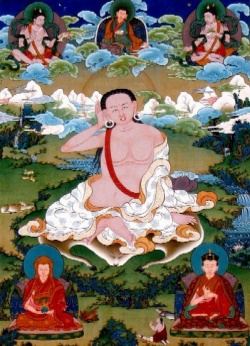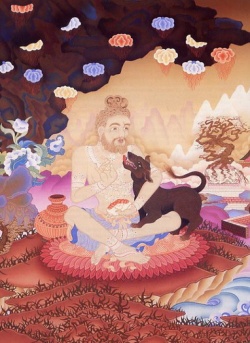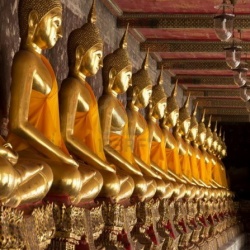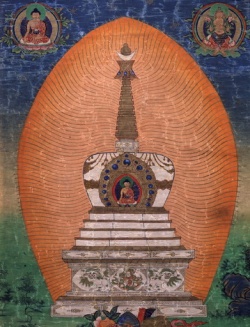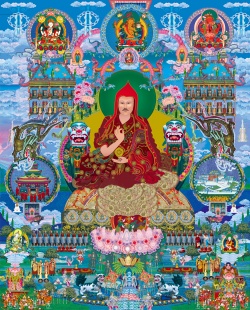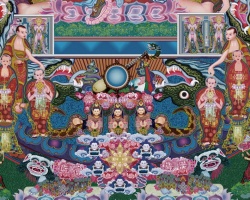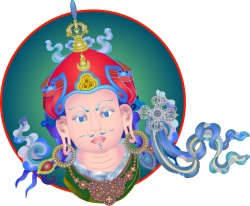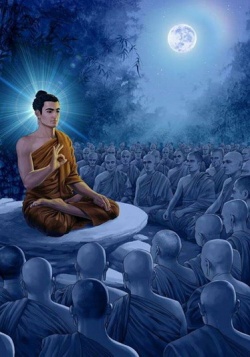Dharmakaya, Emptiness, Sunyata
I chose to post this essay, written for my introduction to Buddhism course, because I love Nagarjuna's theory of emptiness, and because the assignment was also to try to explain the concepts to another person, which turned out to be very amusing. Part of the conversation has been transcribed in the appendix.
Did you look back, O Prajnaparamita, as the strand
Sloped to its foamy edge to greet you
And your foot felt for its sandy landfall—
Did you look back and know, hand hard at your lip,
The journey needless;
That from there, looking back across the labouring waters—
Arrival mirroring the setting-forth—
This is the Other Shore?
The above poem, called Nirvana is Samsara, by P.L. Travers, expresses the 2nd century CE monk Nagarjuna’s Madhyamaka philosophy of emptiness (sunyata), with a particular emphasis on non-dualism: the equality of emptiness and form, and the unity of conventional (samsara) and ultimate (nirvana). As is described in the poem, upon enlightenment the individual experiences the knowledge that, in a sense, she has been enlightened all along – “This is the Other Shore”, and that her self and everything else in existence is inherently empty. This paradoxical doctrine states that emptiness is the very condition that makes existence of things possible (McLellan). Just as a noise can only be heard in relative silence, and light can only be seen in contrast with darkness, form can only arise within the context of emptiness.
Nagarjuna’s philosophical discourse intersects with the Buddhist doctrine of trikaya (tri = three). According to H.V. Guenther, kaya, which is usually translated as “body”, refers to an “existential pattern” whose meaning can only be grasped within its “total situation” (39). Put simply, the Buddha shows up or manifests in three ways or three realms.
The first, called nirmanakaya, corresponds to our ordinary, conventional reality, or samsara. At this level, conventional truths hold, such as the statement: “You are holding a piece of paper”. The Buddha appears here in embodied existence – as a human being, or, according to F. Franck, in “any form…Buddha or beggar, St. Francis or a caterpillar, one’s beloved or one’s archenemy” – whatever serves to facilitate the enlightenment of other beings (51).
The second realm, sambhogakaya, is a realm of light and sound – in other words, of vibration – and the Buddha manifests here in a body of pure vibration; pure light (McLellan). This “Body of Bliss” of the Buddha is “within reach of human perception” (Franck 51) – it is possible for some monks who are well-developed and sensitive enough to perceive and even receive teachings from this subtle body, which is said to have thirty-two marks identifying it as Buddha (Gethin 232).
Manifestations such as various Bodhisattvas and Amida Buddha appear in this realm, and function to connect suffering beings in nirmanakaya or samsara to the ultimate truth of the third body of the Buddha, dharmakaya (Franck 52).
Dharmakaya refers to the ultimate, formless realm of totality. “It is the unthinkable Ground, the timeless plenitude and unitary principle of all being and non-being” (Franck 51). This reality is ineffable – it is impossible to transmit knowledge of it; it must be experienced directly (McLellan). Nevertheless, since the death of the historical Buddha (ca. 486 BCE), some scholarly Buddhists have been attempting to describe and understand it on an intellectual level.
To this end, Nagarjuna identifies dharmakaya as emptiness. Expressions of the ultimate truth of this reality, such as “form is emptiness”, appear absurd and paradoxical when explained at a conventional level. But as P. Fenner points out, “there are experiences to be had which do result in an understanding whereby [such] statements…are rendered true…It is in the reality known as (sunyata) that all spiritual paradoxes and inconsistencies are said to be dissolved” (74-76). Further, from the perspective of dharmakaya, the conventional statement “You are holding a piece of paper” is nonsensical, since ultimately there is no difference between you, the paper and the holding – neither you nor the paper exist independently of each other or the infinite number of conditions that arise and result in “you”, “paper” and the specific relation between you and paper, that of “holding”.
Nagarjuna’s explanation of emptiness is elaborate and difficult, but extremely important in Mahayana Buddhism. Madhyamaka means “middle” school (Gethin 237) – Nagarjuna redefines the Buddhist notion of the “middle way” by attempting, not to find the midpoint between extremes of asceticism and gratification (as did the historical Buddha), but by explicating a viewpoint half-way between the extremes of substantialism (or dualism) and nihilism (Gethin 238). To this end, he emphasized the notions of non-duality and “emptiness as the negation of independent self-existence” (Ives 115).
Firstly, Buddhist emptiness has often been accused of nihilism. According to Christopher Ives, however, “Nagarjuna is not arguing that nothing exists or that we live in an illusory nihilistic void, but that there are no independent, unchanging, permanent essences [of things]” (114). Dharmakaya is a reality empty not of everything, but of all things. It is no-thingness, a lack of thingness. In fact, emptiness is the very condition that makes possible the arising, changing, and ceasing to be of everything that exists on the conventional level (McLellan). Emptiness is like the “space” required for things to move, grow, and change. To slightly elaborate Gethin’s explanation (238), theoretically, a thing that has its own nature, i.e. that does not arise conditioned by other things, could never arise – it could never be caused by anything in existence, for then it would be contingent and conditioned (and lacking in self-existence). Further, such an item, if it already existed, could never change, for then it would cease to be itself – it would be something else. Neither could it cease to exist, because it is its own cause, and nothing outside of it could affect it to make it stop causing itself.
Emptiness, then, as the nature of every thing, is the condition that makes existence as things possible. In addition, it is the foundation for the Buddha’s teachings of the Three Characteristics of Existence and the Four Noble Truths: emptiness assures that everything will be impermanent and have the quality of no-self, which in turn are the conditions that make grasping and craving for permanence the cause of suffering.
Secondly, at the fundamental level, the conventional and ultimate realities are one – as the poem above claims, nirvana is samsara; the trikaya is a “triune”, a triple manifestation of “the One” (Franck 49). Nagarjuna’s philosophy explains reality as non-dual emptiness that nevertheless is identical with the myriad things that arise in the ordinary world. Further, dualism arises from discriminatory consciousness. Ordinary awareness creates a subject/object dichotomy that artificially separates “me” from “the world” – everything I perceive as “not-me”. In contrast, according to Fenner, the experience of sunyata is “an awareness, and perhaps just that, which is beyond the ordinary subject/object duality present in our commonsense experiencing. Being beyond the subject/object division, it is experiencing of a more unifying, integrating and metaphysically fundamental nature” (76), in other words, it is a direct knowing of non-dualism and the inherent emptiness of all things.
Furthermore, “[s]unyata then is an immediate non-differentiable wholeness, neither the world nor apart from the world. It is the ‘intrinsic’ nature of the world” (Fenner 77). Since ultimately, every thing has the same nature, and arises interdependently with everything else (through paticca samuppada), any part of the totality of sunyata implies, and is only made possible by, the whole. Moreover, because ultimately no things exist, including the delusions, defilements and ignorance (Fenner 77) that keep ordinary people from realizing their Buddha-natures, ultimately every being is already enlightened. Since nirvana is samsara, the individual who realizes his own Buddha-nature experiences a shift in psychology only – he perceives the world in universal rather than particular terms. “[N]othing changes in moving from the unenlightened to the enlightened state” (Fenner 77) – except perhaps the quality of experience.
Creative Response: A Dialogue about Emptiness
The task of explaining the virtually unexplainable was both challenging and humorous. My “subject” was my mother (whom I will call “D”), a secular woman approaching sixty who has never (to my knowledge) engaged in much reflection about religion. Thus, at the start of our dialogue, D. was not at all familiar with Buddhist thought, but neither did she have pre-conceived ideas about what a religion should be like, nor bias against non-Christian traditions. Incidentally, I think she was probably the closest thing to a “blank slate” as I could have found for this assignment.
I recorded our conversation and later listened to and transcribed it. This process itself served to illuminate subtle nuances of the dialogue that I probably would not have noticed if I had been working from memory. Unfortunately, I do not have space to analyze them all here, so I have included, in an optional appendix, relevant excerpts that the reader might find amusing and revealing. In addition to these subtleties, some difficulties that I had expected to encounter in describing a paradoxical philosophy became evident quite quickly.
To begin with, I found that it is difficult to talk about Nagarjuna’s teachings without making statements that are contradictory, for example: “we are but we’re not” (i.e. actually existing). Similarly, I was forced to make separate statements that directly contradicted each other, for instance: “Ultimately, there are no things” and “But it’s not a total absence of things”. These inconsistencies were bound to happen in light of Nagarjuna’s two levels of truth, since conventional truths seem to most often be ultimately not true. However, D. did not have a problem reconciling these contradictions once she understood the difference between the two levels of reality, a concept that she readily grasped.
Additionally, it was easier for D. to understand the significance of the idea of emptiness once I had explained it in the context of the Four Noble Truths. Without that information, Nagarjuna’s philosophy was seen as an arbitrary abstract theory – in the first part of our conversation, she asked me “Who has to think these things up? Who cares?” By explaining the connections between emptiness, dependent arising, impermanence, and the goal of cessation of suffering, I believe I was able to demonstrate the usefulness of an understanding of sunyata. In the process of explaining them, I realized again how each of these Buddhist doctrines actually imply and follow from one another. It is not just that they all make sense together – rather, they seem to all be different aspects of the same thing.
I did not find any one concept harder to convey than another, but I noticed that it was especially difficult for D. to understand how things arise or come to be out of emptiness, that is, until I explained the doctrine of conditioned arising and the interdependence of all things in detail (not included in the excerpts). After this, she seemed more comfortable with the idea that things happen in complete dependence on other things.
In the end, D. seemed to agree that Buddhist ideas make sense. However, the transmission of understanding could only be as good as my own “sense” of sunyata. I was aided in this (perhaps) by having previously taken a course in Zen Buddhism and done some research into the ideas of voidness and no-self for a research paper. Because of this, I am not sure the information I conveyed to D. corresponded specifically and exactly to Nagarjuna’s teaching of emptiness. There are elements of later Zen thought and Yogacara in my total understanding of Buddhist ultimate reality, elements that I couldn’t separate from each other. Furthermore, I am not sure that D. came to understand emptiness as completely as she thought she did. It was difficult for her to put it into words, and when she did, she could only repeat back the words I had used. Thus, it was hard to determine whether she genuinely understood, or if she was mistaking her own agreeableness to the concepts for actual comprehension.
D. had a number of responses to the notion of emptiness. At first she described it as “weird” and “bizarre”, and seemed to have difficulty (as was to be expected) reconciling the ultimate non-existence of things with the fact that there were things in plain sight all around her, including her. Eventually, however, after a “crash course” in Buddhist dharma, including the ideas of rebirth, merit, craving, and suffering, she came to think of it all as “quite lovely” and is now considering becoming a Buddhist (see Appendix).
Works Cited
Fenner, Peter. “Samsara is Nirvana.” Australian Essays in World Religion. Ed. Victor C. Hayes. Bedford Park: Australian Assoc. for the Study of Religions, 1977. 73-82.
Franck, Frederick. “A Buddhist Trinity.” Parabola 14 Wint (1989): 49-54.
Gethin, Rupert. The Foundations of Buddhism. New York: Oxford, 1998.
Guenther, Herbert V. “The Experience of Being: the Trikaya Idea in its Tibetan Interpretation.” Developments in Buddhist Thought. Ed. Roy C. Amore. Waterloo: Laurier, 1979. 38-58.
Ives, Christopher. “Emptiness: Soteriology and Ethics in Mahayana Buddhism.” Concepts of the Ultimate. Ed. Linda J. Tessier. New York: St Martin's, 1989. 113-126.
McLellan, Janet. “Mahayana Philosophies.” Wilfrid Laurier University. Waterloo. 30 Nov. 2004.
Travers, Patricia L. “Nirvana is Samsara.” Parabola 11.2 My (1986): 31.
Appendix
(Optional: selected excerpts transcribed from the recorded conversation. M: Refers to myself, D: refers to my “subject”)
-1-
M: What do you think of when I say emptiness?
D: A hole.
M: This doctrine of emptiness is about ultimate reality, what’s really real.
D: Okay.
M: Nagarjuna says there are two levels of truth – conventional truth which is…
D: What you and I believe now.
M: Yes. Regular stuff. And then ultimate truth. The ultimate truth is that none of this is – exists independently of itself. You are empty. Everything is empty, there are no things, ultimately no things. What do you think about that so far?
D: I think it’s pretty weird. (laughs)
M: Are you willing to accept that it might be true?
D: Yep. I’m willing to accept anything might be true.
M: If that is true, what does it mean?
D: Um, that this world is a big empty space, and we’re nothings, I guess.
M: Does that make sense though?
D: Not really but…it’s a new thought and I’m not sure I believe it, but I’m willing to try to understand that it’s a possibility, but it doesn’t make a lot of sense that there’s nothing here. That this is nothing –
M: There’s not exactly nothing, but no-thing. Okay? Emptiness isn’t really empty of everything, it’s just empty of things. Basically there is just a giant flux, a cosmic flux and consciousness is the thing that makes things out of the flux. If you think about it molecularly, there’s a field of molecules, particles, and it’s our consciousness that separates you from the air, from the TV. (D was sitting beside a television set)
D: Okay, alright.
M: So it’s our perception, and the way we perceive things, that makes them into things. When really, ultimately there is just one thing, and its limitless emptiness.
D: So it’s a whole bunch of molecules.
M: Well, no, because you can break down molecules into particles, particles are…ultimately empty as well, because if you break them down…we can see a particle under a microscope, but that’s still [discriminative] consciousness making that particle.
D: This is pretty bizarre that there’s…like…nothing.
M: No-thing.
D: Okay no-thing.
M: If you think about it, you can’t get outside your head. You can’t look objectively at anything, because you are always in your head. You are always using your awareness to look at anything. If there was no human awareness or no awareness period there would be no things period. Awareness is what makes things.
D: Right.
M: I mean, unless there’s God, because God would have awareness of everything. Then he would create things outside of human consciousness. You know what I’m saying?
D: No.
M: Well, because He’s aware. He would create something that would exist objectively…if there would a God, it would exist in his awareness, separate from human awareness.
D: Okay.
M: Do you understand what I’m saying?
D: Yeah I think so
M: But it’s just a big illusion. It’s a shared illusion, that [for example] that’s a TV. Nothing is permanent, no thing is permanent, everything is always changing, and emptiness is what makes things possible in the first place. Because, if something was independently in itself had its own existence within itself, it could never come to be and it could never cease to be, because as soon as it’s changed, it would not be itself. It would be something else.
D: That’s right. Okay.
M: So, that TV is impermanent, always changing and does not have its own existence, it’s empty of its own existence.
D: Because it’s always changing.
M: Right. And everything is like that.
D: Okay, alright.
M: So explain back to me what you’ve learned so far.
D: That nothing is, anything doesn’t really exist, because it’s always changing. It’s not…there. This is all a theory right?
M: Yeah. Nagarjuna’s explanation.
D: Okay. It’s not there because it’s always changing so it’s not really there. And it wouldn’t ever, and it wasn’t there in the first…no.
M: Well, on a conventional level everything is here.
D: Yeah, I know, but we’re talking about his…
M: Ultimately, there are no things.
D: Yeah, so there’s no television, because it’s always changing and it isn’t there because of that?
M: Well…Okay what’s emptiness then?
D: A no thing. There’s nothing there.
M: But it’s not a total absence of things.
D: No?
M: It’s emptiness, it’s what makes everything possible.
D: Emptiness makes everything possible because you can make whatever you want…
M: Because the nature of everything is emptiness, and that’s what makes things come into being, change, and then go out of being.
D: The nature of everything is emptiness.
M: Meaning it doesn’t have its own existence, it’s not in itself, it doesn’t create its own, it’s not stable, it’s not permanent. Okay?
D: Alright. Who has to think these things up? Who cares, Michelle? (laughing)
M: I do! I think it’s interesting.
D: Oh my God! Okay. Now I still have to tell you what empty is?
M: Well let me finish.
D: Okay.
M: Basically what they are saying at the end is that emptiness is form, and form is emptiness. So that’s what I am trying to explain, how one makes the other possible.
D: Okay so…
M: Eventually they are the same thing. The conventional realm and the ultimate realm is the same realm it’s just…
D: In a different spot in it?
M: It’s not dual, it’s a different perspective maybe. Ultimately, it is emptiness but from our perspective it’s full of things, full of form.
D: Yes, full of forms.
M: But it’s the same, there’s not two different realms or two different worlds, you know, like heaven, it’s all one.
D: Because all of these things that we perceive are usually constantly changing and then go away…
M: Not usually, always.
D: Always. Okay, they’re always changing and they go away and then something else is able to be formed again and then it changes and it goes away, and the going away…um…things couldn’t be formed and go away if there was no emptiness in the first place, if there was nothing, no-thing there in the first place. If there wasn’t an empty space, I’ll just say it’s an empty space, I know it has…
M: But it’s not space.
D: No. Okay. We’ll use the television as an example. At first there was none, in our mind, because physically, no one had invented it. So it’s a nothing, a no-thing. And someone thinks of it, and forms it, and it keeps changing until the point where…because there was no television, someone was able to think it and form it, and it changed and so…is that right? So it’s…there was nothing, and it’s… there was no-thing, there was no television. And if there was, then no one would be able to think it up because it was there already. So…Yes? No? Am I getting it?
M: Well I mean if there was…
D: Okay so if there was no couch, if there was no such thing of a couch, and then someone thinks it up and perceives it…
M: Well it’s not really a matter of…a person is a thing just like any other thing…
D: Right…I know…
M: So it’s not like…I understand what you’re saying, it’s not exactly right I don’t think.
D: Oh.
M: Buddhism talks about dependent arising, which is…
D: What does that mean?
M: It means that things…well basically it means the same thing. That things that don’t exist in themselves, they depend on every other thing that’s going on, to arise.
D: To arise, to be?
M: Arose, like come into being. So everything depends on everything conditioned. So that television arose because of the conditions that were going on that conditioned the television, and the human being creating it is part of those conditions. So it’s the awareness that makes it a television, the naming it…so the TV is not independent of anything, especially not the person who sees it as a TV.
D: Right. Right. Right.
M: So. (pause). I don’t know if I got it, I don’t know if I totally understand…so…(laughing)
D: Oh…
M: Well I mean, you can’t really understand, it’s not something understandable per se, like you have to experience it directly to really know…
D: And how would you do that?
M: Well you become enlightened.
D: Oh, I see. Have you become enlightened?
M: No. This is what….people meditate for years and years and years. It’s what the Buddha saw on his enlightenment.
D: Oh I see.
M: The emptiness, they see this when they become enlightened, they become this.
D: So Buddhists pray to the Buddha?
(here followed a general discussion of Buddhism: the four noble truths, the realms of rebirth, Bodhisattvas, devotionalism, monks vs. lay people in modern Buddhism, merit, karma etc.)
-2-
M: Emptiness is empty even of emptiness.
D: Oh come on now (laughs).
M: Well because emptiness is a concept, and real ultimate reality is beyond conceptual thinking beyond…Conceptual thinking creates dualism. Okay, if I say a word, like “good”, it automatically creates “bad” – “good” does not make sense unless in contrast to “bad”, okay?
D: Yes.
M: So any talking or thinking, because thinking is based in language as well, creates dualism which is not ultimately there.
D: Okay.
M: So the ultimate reality is both good and bad, and neither good nor bad…it’s like the totality before you get A and not-A. It’s both and neither A and not-A.
D: So emptiness is nothing.
M: No not nothing. It’s no-thingness.
D: Okay.
M: But it is also form.
D: Yeah so it’s not empty.
M: No it’s not empty.
D: Okay I got it.
M: Form is inherent in emptiness because that’s where form comes from. But it’s not like emptiness is here and form happens or springs out of emptiness, it happens within the emptiness itself, which is….both conventional reality and ultimate reality. It’s one thing.
D: Form doesn’t spring from emptiness?
M: It does, but it doesn’t happen somewhere else. It happens within the emptiness.
D: No, yes, okay. Right.
M: So emptiness is empty even of emptiness. It’s not nothing it’s not a thing, it’s both empty and not empty and neither empty nor not empty. You know what I mean?
D: Yep, okay.
M: It’s pre-emptiness, pre-conceptual, pre-everything.
D: Yeah okay, I got that.
M: I’m just not sure…Either you do get it, or I’m not explaining it right or I don’t understand it…
D: I really think I get it. And it sounds quite lovely actually!
I sometimes write things that I don't really mean or believe. These are not to be taken literally, nor as definitive statements about me or my beliefs. Thoughts and emotions are transient, and I reserve the right to change my mind, generalize, exaggerate, give strong opinions, or write other possibly offensive statements. I don't lie, but I may say something that's not true to check whether I believe it or not, or to make a point. Call it creative license. This is my blog, and do have the right to say what I want. I'm using it in creatively therapeutic ways. Whatever the reader may think of me and my words, please believe that my core intentions are always good and I never willingly hurt anyone.
